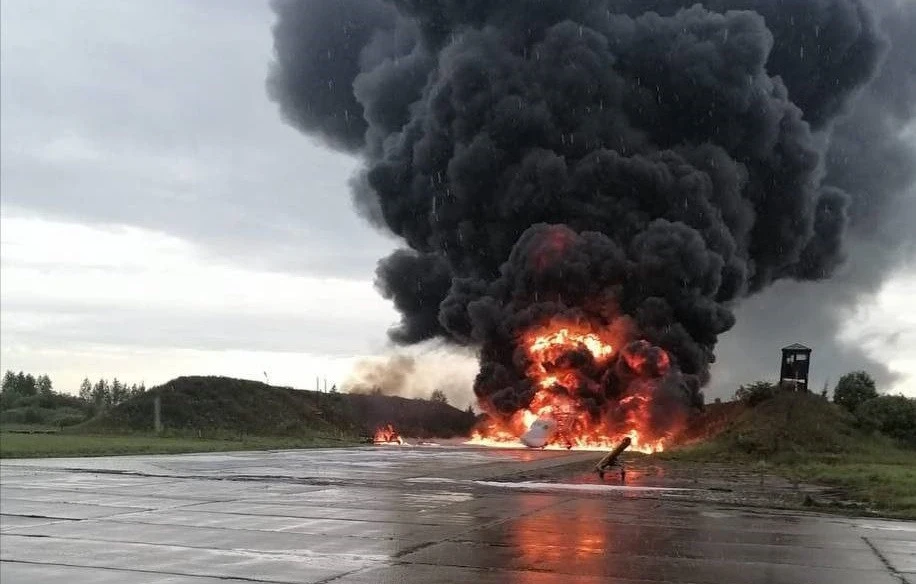
Russia's Tu-22M3 strategic bomber crash: production numbers and remaining fleet
The loss of each Tu-22M3 long-range bomber is a significant blow to Russia, as it relies heavily on aging Soviet-era equipment and plans that are long overdue for replacement
Defense Express information and consulting company writes about this.
After the recent crash of another Tu-22M3 long-range bomber in the Irkutsk region on August 15, it’s worth questioning how many of these aircraft Russia produces annually and how many are still operational.
These aircraft face losses not just from accidents but also from successful Ukrainian Defense Forces' operations. Specifically:
- Two were damaged by long-range drones at the Olenya air base on July 25, 2024.
- One was shot down by an S-200 on April 19, 2024.
- One was destroyed and two were damaged at the Soltsy air base following a drone attack on August 19, 2023.
- Three, according to Russian prosecutors, were damaged at the Dyagilevo air base due to a long-range drone attack on December 5, 2022.

It's important to note that even if these aircraft are damaged, there's no guarantee they will be repaired and returned to service. They could potentially become irreversible losses.
“Especially given that Russia does not produce any version of the Tu-22M at all, as the last Tu-22M3 was produced in 1993. And the only reserve that Russia is already using is up to six airframes that have been standing in the open for about 30 years. In addition, Russia may try to restore aircraft that have already been decommissioned and are in storage,” defense Express writes.
According to Defense Express, the main challenge for Russia is that the NK-25 engines for the Tu-22M3 are no longer in production; they were last produced in 1996. This significantly limits the possibility of restoring additional aircraft.
To address this issue, the latest modernization of the Tu-22M3M was designed to use NK-32 engines from the Tu-160. Production of the NK-32-02 version was resumed in 2016, but only in very limited quantities. These engines are essential not only for the Tu-22M3 modernization but also for the Tu-160M, whose production has been partially based on Soviet-era stock.
However, there have been no reports of NK-32 engines being installed in the Tu-22M3M. The planned modernization, which aims to upgrade 80% of the aircraft's onboard electronic systems, expand its weaponry, and add an aerial refueling capability, is intended to extend the aircraft's operational life by only about 10 years.
Moreover, the modernization timeline has already been significantly delayed, and there are confirmed reports of only two Tu-22M3Ms, with one being ready in 2018.
Therefore, each loss of Tu-22M3 is more than significant for Russia, given that no new aircraft are being produced and the country is largely relying on the remnants of Soviet-era technology. There are no current replacements for these aircraft or for other strategic bombers like the Tu-95MS and Tu-160. In fact, after 12 years of discussions about a potential replacement, only a preliminary outline has been approved.
As of mid-2023, estimates in Military Balance indicate that there are 57 Tu-22M3 aircraft “on paper.” These are operated by the 200th, 52nd Heavy, and 40th Mixed Air Regiments, based at airfields in Belaya, Shaykovka, and Olenya.
Additionally, it’s crucial to note that the Russian Federation planned to modernize only up to 30 aircraft to the Tu-22M3M level. This figure serves as a benchmark.
From this number, at least two aircraft lost and several damaged ones should be subtracted. However, the actual number is likely higher, as not all Tu-22M3s are in combat-ready or flying condition. While these aircraft were actively used in 2022, their operational use has since decreased to just a few instances, Defense Express concludes.
- On August 15, a Tu-22М3 long-range supersonic bomber firing Kh-22/Kh-32 missiles at Ukraine crashed in the Irkutsk region of Russia
- News














































